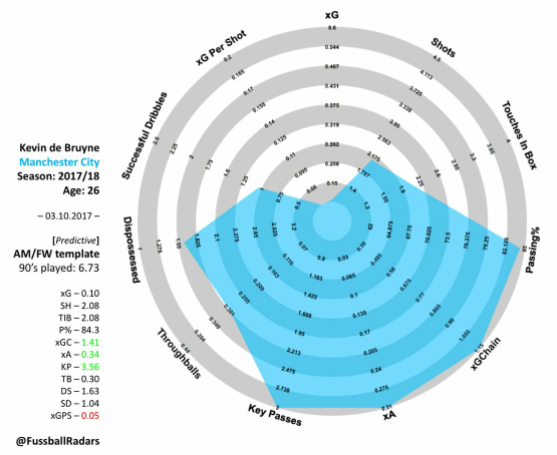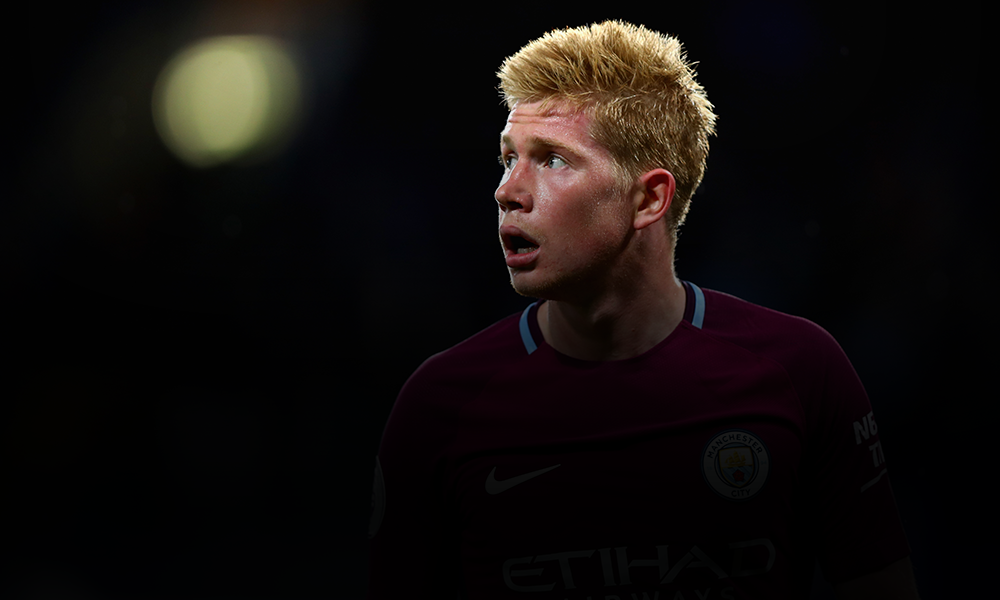Charles Onwuakpa analyses Kevin De Bruyne, who has quickly developed into Pep Guardiola’s most important player.
When we talk about tactics today, there is often a negative tendency to consider them less important than mere individual skills: people claim that “players win games”, emphasising the dominance of individual skill over the tactical concepts of shape, balance, system fluidity & organization.
This sentence is quite true: players win games indeed, but they don’t win tournaments; no matter how good they are, tactical organization and balance are indeed key to long-term success.
In contrast to that sentence, I personally believe that, tactically, ideas can take football almost anywhere: a perfect example of this is Total Football.
As you might probably know, Total Football (in Dutch totaalvoetbal) is a tactical theory of football in which any outfield player can take over the role of any other player in a team. It was made famous by Rinus Michels, Johann Cruyff & the Netherlands national football team in the 1974 FIFA World Cup.
In Total Football, a player who moves out of his position is replaced by a team mate, while retaining the team’s intended organisational structure. In this fluid system, no outfield playerd has a fixed role; anyone can successively play as an attacker, a midfielder and a defender. The only player who must stay in a specified position is the goalkeeper.
Total Football’s tactical success depends largely on the adaptability of each footballer within the team, in particular the ability to quickly switch positions depending on the on-field situation. The theory requires players to be comfortable in multiple positions; hence, it places high technical and physical demands on them.
It’s no suprise then that Pep Guardiola, the best manager in the world in terms of the “Positional Play” (in Spanish Juego de Posicion) football theory application & the natural disciple of Cruyff, has integrated this aspect into his coaching style at Manchester City: we saw it last year with the “inverted full backs” experiment and are experiencing it once again this season with City’s playmakers, David Silva & Kevin De Bruyne; the latter mainly, in his free-roaming No8 role has arguably been the best player in the league this far this season.


Courtesy of @FussballRadars
Under Pep Guardiola, the Belgian has evolved into an all-rounder rather than a mere dynamic attacking midfielder: below is a break down of his five main duties as a Total Midfielder.
Kevin De Bruyne: The Defender
Although Pep Guardiola prefers him teams to defend with the ball, this doesn’t mean that they don’t focus on positional defending: when out of possession, Pep’s teams focus on blocking passing lanes; interceptions are more important than tackles, and are a more reliable defensive instrument: intercepting the ball not only offers less risks of conceding fouls in dangerous areas, but also allows teams to be effective in attacking (or positive) transitions. While intercepting, City are proactive: they defend with a predetermined plan when they retain possession; tackles, on the other hand, are reactive actions so are in high contrast with Guardiola’s concept of total control in a game: he strongly believes that his teams must be dominant in all phases, with great emphasis on the transitional phases.
In De Bruyne, Guardiola has an adept defender: he reads games well and manages to steal the ball by predicting the nearest passing lane and blocking shots.
Kevin De Bruyne: The Presser
Apart from intercepting, City press & counterpress high up the pitch in order to prevent the opponents from a clean buildup as well as pin them back in their own third. This is physically demanding and requires high intensity for all 90+ minutes. The 26-year-old is strong runner on and off the ball: his pace and aggressiveness are key for Guardiola’s high pressing demands; it is common to see him press in extremely high positions, even the goalkeeper if required.
While Johann Neeskens performed this duty with large success for the Netherlands back in the 1970s, the same can be more or less said about Kevin.
Kevin De Bruyne: The Playmaker
As the opposition’s full backs are often pinned back by City’s wingers (for eg: in their 0-1 win vs Chelsea), De Bruyne has a lot of space to play in while Silva operates in the hole: he mainly drifts centrally and wide to combine with Kyle Walker, allowing the English defender to get tons of space in which he can run into (with overlaps or underlaps). De Bruyne is expected to cover a lot of ground, which he does well thanks to his stamina, as well as initiate attacks in free areas; in fact, despite Guardiola being tactically strict, total freedom is given to his creators: free spaces must be always occupied in order for play to progress into the attacking third.
The Belgian has the tactical awareness needed to find these pockets of space and link up with his team mates, creating passing triangles and diamonds around the pitch.
He also possesses the vision and eye for a pass, getting Sané, Sterling, Mendy or Walker on the run with excellent long balls in order exploit the width of the pitch: his distribution permits City’s wingers/wing backs to test their markers in 1vs1 situations and thrive in attacking transitions at the speed of light.
Kevin De Bruyne: The Creator
On paper, David Silva & Kevin De Bruyne are both attacking midfielders but actually have different styles of play; David Silva excels in short passing & protecting the ball in tight spaces whereas De Bruyne is better in long passes with his quarterback precision; the Spaniard has a more patient approach and works up the tempo in the final third by starting those one-touch slick combinations which have been effective over recent years for City; De Bruyne is more dynamic in the attacking third, which is really good if you need to play a positional game and speed up play, but not so good when you have to combine in short spaces as his intensity of play can hamper the precision you need to be efficient.
David Silva has “La Pausa”, De Bruyne doesn’t: this is their biggest difference; although the Belgian has created more chances so far this season (24 vs 23), he has had less assists (3 vs 6) and created less chances from open play (10 vs 20). A large number of De Bruyne’s chances comes from his set-pieces and crosses, which makes his style of play highly complementary with the Spaniard’s and guarantees Pep Guardiola an efficient use of aerial space.
Kevin de Bruyne: The Goalscorer
This week De Bruyne was included in the 50-man list for the Ballon d’Or: he obviously won’t win it, but it makes sense for him to be in there. Although his goalscoring rate is lower as he now plays further from goal, he has a massive impact in big games: we saw it vs Chelsea two weeks ago, or against Shakthar in the Champions League, or even vs Manchester United and Barcelona last season to name a couple of games.
Despite scoring less than before, he steps up when needed with his composure in front of goal and good shot accuracy, as he hits the ball with power and precision.
Conclusion
At 26 years of age, De Bruyne has fastly become one of Europe’s finest midfielders and, perhaps, the latest tactical evolution performed by Pep Guardiola.
After leaving Chelsea in 2014, he has enjoyed fine spells in Germany and England as well as radically improved his all-round game while on the verge of reaching the peak of his career.
Manchester City will desperately need trophies this season as Pep’s tenure at the club will be – rightly or wrongly- judged by how many titles they will win considering the incredible money spent over the past two years.
With Pep’s ideas and De Bruyne’s talent though, Manchester City could go almost anywhere.
























































